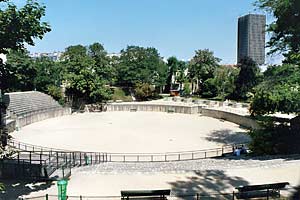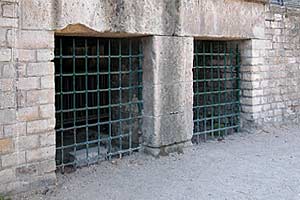 |
 |
 |
| |||||||||||||


|
|
|||

Arènes de Lutèce, viewed from upper bleachers. (Jussieu campus tower in background) ©2003 Ian C. Mills, Discover France The city of Paris is so layered with history, it's easy to forget that beyond the Renaissance palaces and Gothic cathedrals there lie traces of the city's Roman heritage. Named Lutèce, after the Latin Lutetia, Gallo-Roman Paris was a prosperous town stretching from the Ile de la Cité to the Left Bank. Paris' 5th arrondissement, covering what was once the "new town", is home to the only remaining vestiges of the Gallo-Roman era in Paris. These include the remains of the thermal baths at Musée de Cluny, and the Arènes de Lutèce. The Arènes are particularly pleasant to visit during spring and summer, when the amphitheater is taken over by students enjoying an outdoor lunch, children playing soccer, or men engaged in the venerable game of pétanque (boules). Built toward the end of the first century A.D. on the slopes of the Montagne Sainte-Geneviève outside Lutèce, the Arènes were used as a theater, circus, and sporting arena. The style of construction is relatively rare for an amphitheater of its period, different from the round or classical oval (Latin: cavea) style. 
A friendly game of pétanque being played in the Arènes de Lutèce. ©1999 Frédéric Phan While similar types may be found at Senlis, Drevant, and Vieil Evreux, the amphitheater in Paris is thought to have been the largest of its kind constructed by the Romans. The sunken arena was surrounded by the wall of a podium 8.2 feet (2.5m) high, surmounted by a parapet (Latin: balteus). The presence of a 135-foot (41.2m) long stage allowed scenes to alternate between theatrical productions and combat. A series of nine niches aided in improving the acoustics. Five cubbyholes were situated beneath the lower bleachers, of which three appear to have been animal cages that opened directly into the arena. Historians believe that the bleachers, which surrounded more than half of the arena's circumference, could accommodate as many as 17,000 spectators. Upper bleachers were relegated to slaves, the poor, and women — while the lower seats were reserved for Roman dignitaries. For comfort, a linen awning (Latin: velarium) sheltered spectators from the hot sun. Circus acts showcased wild animals and gladiatorial contests; popular theatrical productions of the time were the tragedies of Aristophenes and Plautus. From its vantage point, the amphitheater also afforded a spectacular view of the Bièvre and Seine rivers. 
Animal cages under the lower bleachers of the Arènes. © Insecula.com When Lutèce was sacked during the barbaric invasions of 280 A.D., some of the structure's stone work was carted off to reinforce the city's defenses around Ile de la Cité. Subsequently, the amphitheater became a cemetary, and then it was filled in completely following the construction of Philippe Auguste's walls (ca. 1210). Centuries later, even though the surrounding neighborhood (quartier) had retained the name les Arènes, no one really knew exactly where the ancient arena had been. It was discovered by Théodore Vaquer during the building of the Rue Monge between 1860-1869, when the Compagnie Générale des Omnibus sought to build a tramway depot on the site. Spearheaded by the author Victor Hugo (1802-1885) and a few other intellectuals, a preservation committee called la Société des Amis des Arènes undertook to save the archaeological treasure. After the demolition of the Couvent des Filles de Jésus-Christ in 1883, one-third of the arena was uncovered. The Municipal Council dedicated funds to restoring the arena and establishing it as a public square, which was opened in 1896. After the tramway lines and depot were dismantled in 1916 and line 10 of the Paris métro was constructed, the doctor and anthropologist Jean-Louis Capitan (1854-1929) continued with additional excavation and restoration of the arena toward the end of World War I. The neighboring Square Capitan, built on the site of the old Saint-Victor reservoir, is dedicated to his memory. Unfortunately, a portion of the original arena — opposite the stage — was lost to buildings which line rue Monge (see picture).
Street map of 5th arrondissement,
vicinity of Arènes de Lutèce. ©2005 Ian C. Mills, Discover France 
Three principal public entrances: (1.) 10, rue des Arènes (through Square Capitan) (2.) rue de Navarre (gate entrance) (3.) 47, rue Monge (passageway through building) CLICK ON MAP TO ENLARGE Today the Arènes de Lutèce is a public park, accessible by entrances on three sides. One is a passageway through the building at 47, rue Monge; the second is a long open corridor (vomitoir) accessible from rue de Navarre through a gate; the third is through the Square Capitan from its entrance at 10, rue des Arènes. The open seating of the arena is backed by banks of grass, shade trees, and a romantic garden. There are lots of tucked-away places to sit with a book or enjoy a picnic. Standing in the center of the arena one can still observe significant remnants of the stage and its nine niches, as well as the grilled cages in the wall. The stepped bleachers are not original, but historians believe that 41 arched openings punctuated the façade. You'll have to use your imagination, but there is certainly enough structure left to get the feeling of the place. Commemorative plaqueA plaque on the wall of the rue de Navarre entrance to the Arènes bears the following inscription: « C'est ici qu'a pris naissance au deuxième siècle de notre ère la vie municipale de Paris. Dix milles hommes pouvaient tenir à l'aise dans les arènes de Lutèce où les joutes nautiques succédaient aux luttes de gladiateurs, les combats de fauves à la représentation des comédies et des drames. Passant songe devant ce premier monument de Paris que la ville du passé est aussi la cité de l'avenir et celle de tes espoirs. Translation: « It was here in the second century A.D. that the municipal life of Paris was born. Ten thousand men could keep comfortable in the arenas of Lutèce where jousting and gladiator combat was followed by wild animal fights, presentations of ancient comedies and dramas. When passing before this first monument of Paris, consider that the city of the past is also the city of the future and that of your hopes. [1.] Friends of the Arènes de Lutèce. The plaque was inaugurated on Sunday, 1 July 1951.
Surrounding areaAfter visiting the Arènes, cross the Rue Monge and climb the elegant staircase to the Rue Rollin. This narrow, charming pedestrian street will lead you to the Place Contrescarpe. If you'd rather avoid the stairs, take the rue Lacépède which brings you directly into the Place. Contrescarpe is a picturesque and popular square, surrounded by cafés and featuring a fountain at its center. It is the starting point for a visit to rue Mouffetard, Paris' most famous market street. Editing, translation, and portions written by Ian C. Mills © 2000- – All Rights Reserved. Sources: This City Paris, Claire Downey, editor & publisher, from Newsletter (December 2003 issue). Insecula.com, Guide intégral du voyageur. Text from on-site placard erected by the Direction des Parcs, Jardins et Espaces Verts (Paris Parks Department). Paris.fr, web site of the Paris Convention and Visitors Bureau. Images: 'Arènes de Lutèce (Jussieu campus tower in background)' and 'One side of the arena obscured by buildings on rue Monge' and 'A plaque on the wall of the rue de Navarre entrance to Arènes de Lutèce', photographer: Ian C. Mills (April 2003), Discover France. 'A friendly game of pétanque in the Arènes', photographer: Frédéric Phan (1999), from Paris en Photos. 'Pétanque is popular at Arènes de Lutèce', photographer unknown, from OuSeBouger.com. 'Animal cages under the lower bleachers of the Arènes de Lutèce', photographer unknown, © Insecula, Guide intégral du voyageur. 'Street map of 5th arrondissement, vicinity of Arènes de Lutèce', ©2005 Ian C. Mills, constructed by stitching together separate métro route maps from RATP. All Rights Reserved. |
|||

|
||||||||||